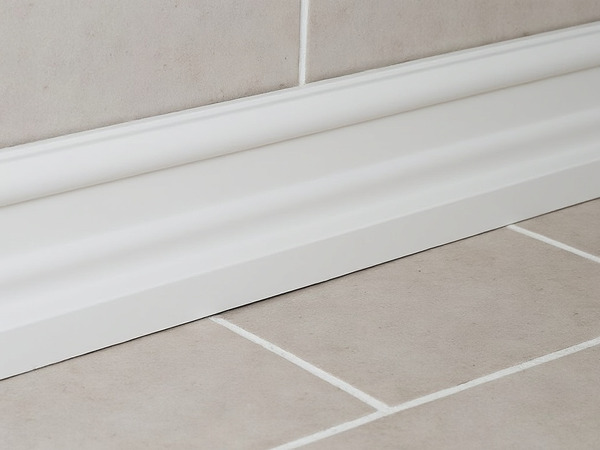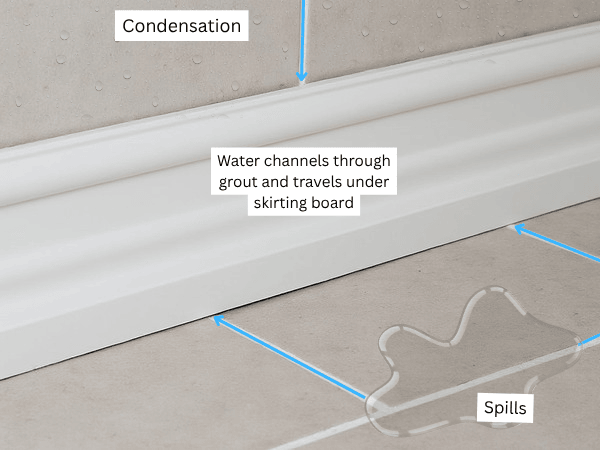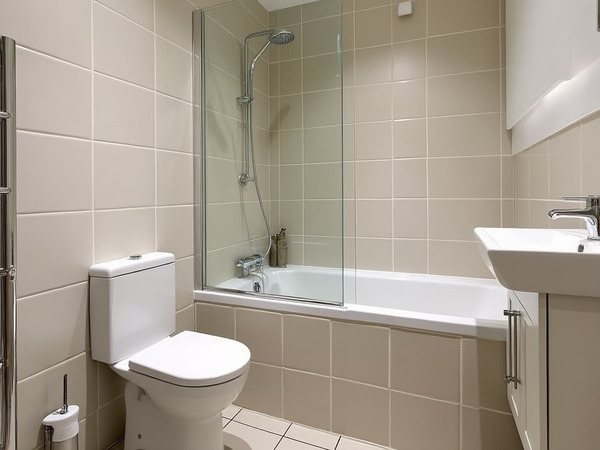Posted by Wall Panels World on 14th Oct 2025
Tiled Floors And Tiled Walls | Skirting Boards Or Not? | Best Solution
Tiling a bathroom or kitchen from floor to ceiling raises an obvious question: what happens at the junction where floor tiles meet wall tiles? Traditional skirting boards create problems in fully tiled rooms, particularly around moisture. The solution isn't always obvious, and getting it wrong means problems later.

The moisture problem with traditional skirting
Standard MDF skirting boards absorb water. In bathrooms, this happens through condensation dripping down tiled walls. In kitchens, spills and cleaning water find their way behind the tiles and into the board.
The real damage happens at the grout line where floor tiles meet the skirting. Water channels through the grout, gets trapped behind the board, and sits there. MDF swells, paint bubbles, and within months you're looking at visible deterioration.

Standard installation

How water gets in
Even moisture-resistant MDF isn't waterproof. It handles humidity better than standard MDF but can't cope with direct water exposure. Wood behaves similarly unless you're using marine-grade ply or hardwoods like teak, which most people aren't fitting as skirting.
The grout line is the weak point. No matter how well you seal it initially, movement between floor and wall eventually creates hairline cracks. Water finds these gaps during normal use.
What to consider
Several factors beyond moisture affect whether skirting boards work in fully tiled rooms.
Thickness alignment
Wall tiles add 6-10mm depth to your skirting boards. If your architraves (door trim) are thinner than your skirting plus tiles, everything looks wrong. The skirting sticks out beyond the door frame, creating an awkward junction that's difficult to resolve neatly.
You can use thinner skirting boards, but this limits your profile choices. Or you can adjust architrave thickness to match, but that means custom work and additional cost. Most people discover this problem too late, after the tiles are installed.
Protection versus aesthetics
Skirting boards traditionally protect walls from furniture knocks and vacuum impacts. With fully tiled walls, the tiles themselves provide protection - assuming they're installed properly. Porcelain tiles are particularly tough at the base of walls.
The aesthetic argument works both ways. Traditional rooms suit skirting boards. Modern bathrooms and kitchens often look better without them, particularly in smaller spaces where the unbroken line of tiles makes rooms feel larger.

Maintenance requirements
MDF and wood skirting in wet areas need regular attention. Paint deteriorates faster near moisture. Sealant along the base needs replacing periodically. Fully tiled installations, by contrast, require occasional grout touching up but otherwise maintain themselves for years.
Better alternatives
Several approaches work better than traditional skirting boards in fully tiled rooms.
PVC wall panels
PVC wall panels eliminate the floor-wall junction problem entirely. They run from floor to ceiling, creating a completely waterproof surface with minimal joints. No grout lines means nowhere for water to penetrate.
Installation takes a fraction of the time compared to tiling. Panels fix to the wall with adhesive, with edges sealed using silicone. The base sits directly on the floor, sealed with the same silicone, creating a watertight barrier.
No skirting needed
PVC panels solve the moisture problem by covering the entire wall. No junction between materials means no weak points for water damage.
View PVC wall panelsNo skirting at all
Tiling wall to floor with no skirting creates the cleanest look. Tile down to within 5mm of the floor, grout the tiles, then seal the remaining gap with flexible silicone. Use mould-resistant, sanitary-grade silicone - brands like CT1 or Demsun work well.
The silicone accommodates movement between floor and wall while keeping water out. This method requires careful installation but delivers excellent results in modern interiors.
Skirting tiles
Purpose-made skirting tiles feature chamfered or rounded edges designed specifically for the floor-wall junction. They integrate visually with floor tiles and handle moisture properly when installed with flexible, waterproof adhesive.
This approach maintains the traditional skirting look while avoiding the problems of MDF or wood. Installation follows similar methods to regular tiling, with particular attention to flexible grout and sealant at the base.
PVC skirting boards
PVC skirting boards mimic traditional profiles but handle moisture properly. They're particularly useful when matching existing rooms or maintaining consistent trim throughout a property. Fix them with waterproof adhesive and seal all joints with silicone.
Installation tips
Tiling sequence
Tile most of the wall first, leaving the bottom row for later. This prevents debris and grout falling onto completed floor tiles. Once the floor is tiled, complete the bottom wall row for a neat junction.
If you're installing skirting over tiles, fix them after both floor and wall tiling is complete. This lets you see the actual alignment and adjust as needed.
Adhesive selection
Use flexible, waterproof tile adhesive for wall tiles near the floor. This absorbs slight movement and reduces the risk of tiles cracking from impacts. For PVC panels, high-tack panel adhesive creates permanent bonds.

Sealing properly
Whether you're using tiles, panels, or skirting boards, seal the floor-wall junction with quality silicone. Apply it in one smooth motion, tool it immediately, and let it cure fully before exposing it to water.
Flexible grout at tile joints and silicone at expansion gaps creates a system that moves slightly without cracking. This matters more at the base of walls where thermal expansion affects floor tiles.
Metal tile trims provide additional protection if you're concerned about impacts at the base. Aluminium or stainless steel profiles sit at the tile edge, absorbing knocks that might otherwise chip tiles.
What works best
Traditional MDF or wood skirting boards don't suit fully tiled wet rooms. The moisture risk outweighs any aesthetic or protective benefits. For the best combination of durability, appearance, and practicality:
PVC wall panels eliminate the problem entirely. They're completely waterproof, quick to install, and need minimal maintenance. Available in tile effects, marble finishes, and various other styles, they suit modern bathrooms and kitchens particularly well.
Tiles meeting tiles with no skirting creates the cleanest modern look. Properly sealed with flexible silicone, this approach handles moisture perfectly and requires minimal ongoing maintenance.
Skirting tiles work for traditional aesthetics while maintaining proper moisture resistance. They integrate seamlessly with tiled surfaces and last indefinitely when installed correctly.
PVC skirting offers traditional profiles with modern waterproof properties. It suits situations where maintaining consistent trim throughout a property matters more than achieving a contemporary look.
In dry areas, standard MDF skirting boards work fine. In wet zones, choose materials designed for moisture exposure. The decision ultimately depends on your room's function, design preferences, and practical requirements.
Common questions
Can regular floor tiles work as skirting?
They can, but purpose-made skirting tiles with chamfered edges look more professional. If using regular tiles, precise cutting and possibly adding a metal trim improves the finish considerably.
Do I need to seal the gap between tiles and floor?
Yes. Without skirting boards, silicone at this junction prevents water penetration that can damage the substrate. Use mould-resistant, sanitary-grade silicone designed for wet areas.
How do I fix alignment issues with architraves?
Consider tile thickness when selecting skirting depth. You may need thinner skirting or thicker architraves to achieve a flush finish. Alternatively, omitting skirting entirely avoids this problem in modern installations.
What adhesive works for skirting in wet areas?
Waterproof construction adhesive provides strong bonds in moisture-prone environments. For PVC panels, use high-tack panel adhesive. Always supplement with appropriate sealant at joints and edges.
Are there moisture-resistant wood options?
Marine-grade plywood and hardwoods like teak handle moisture better than standard wood. However, proper sealing with waterproof finishes remains essential. For wet areas, PVC alternatives generally perform more reliably with less maintenance.


